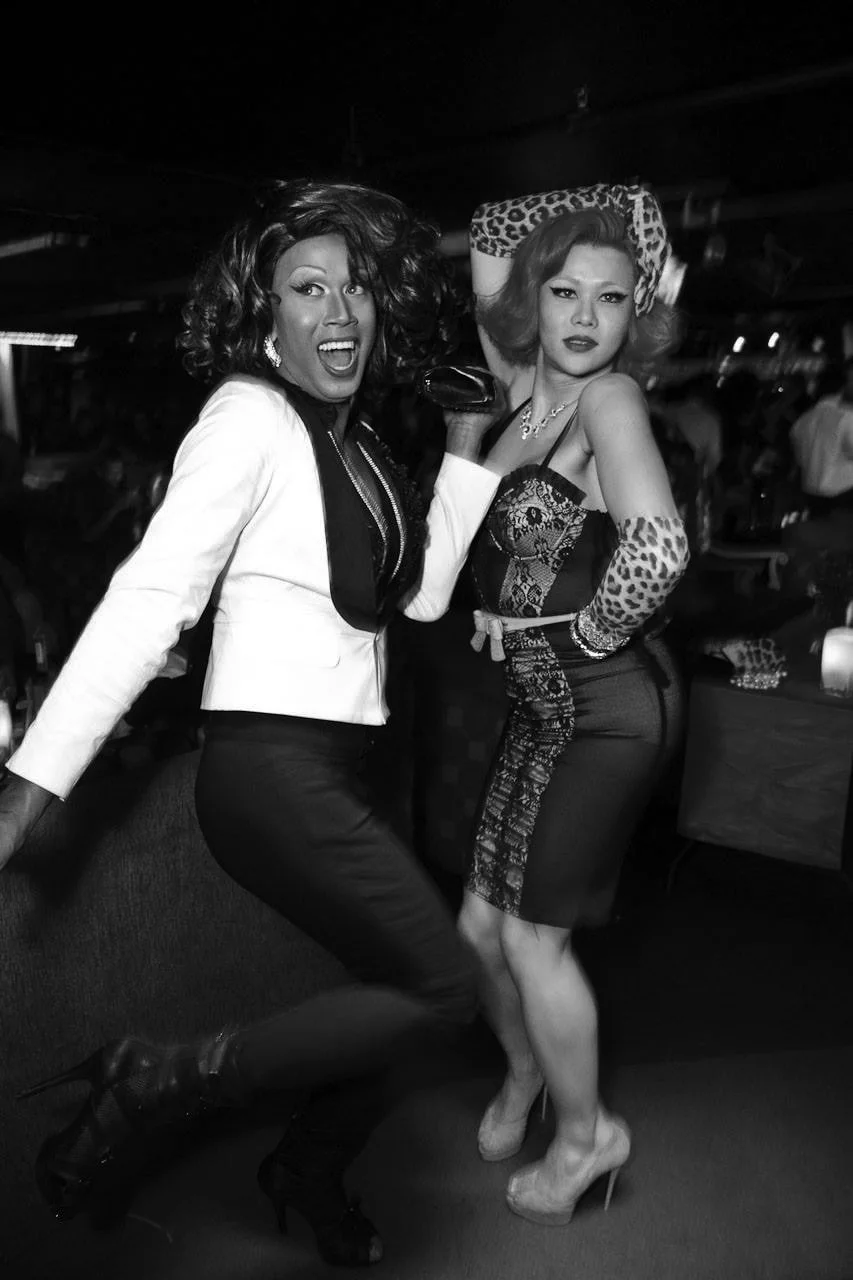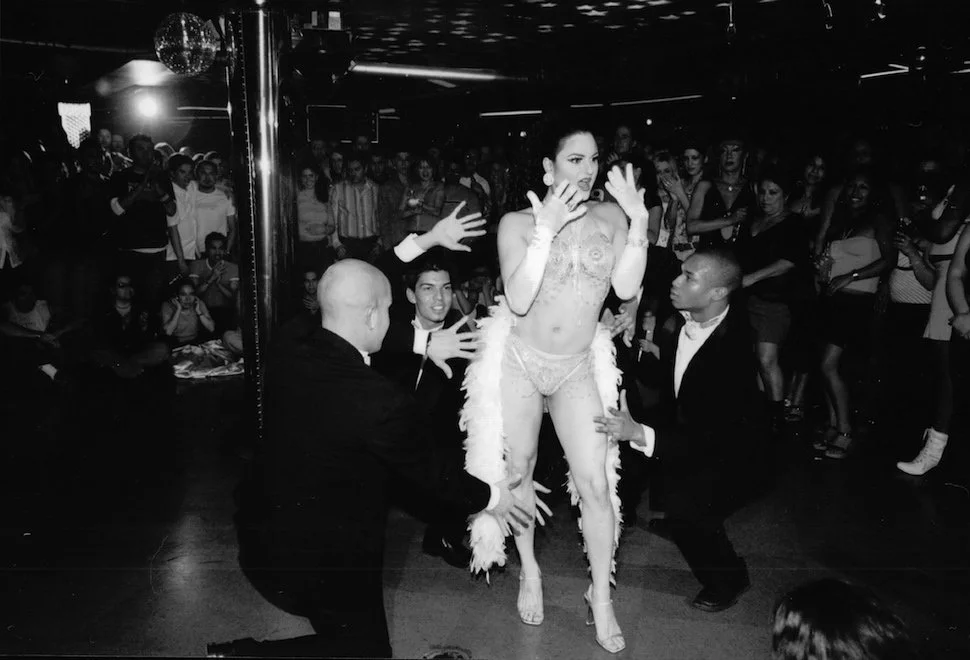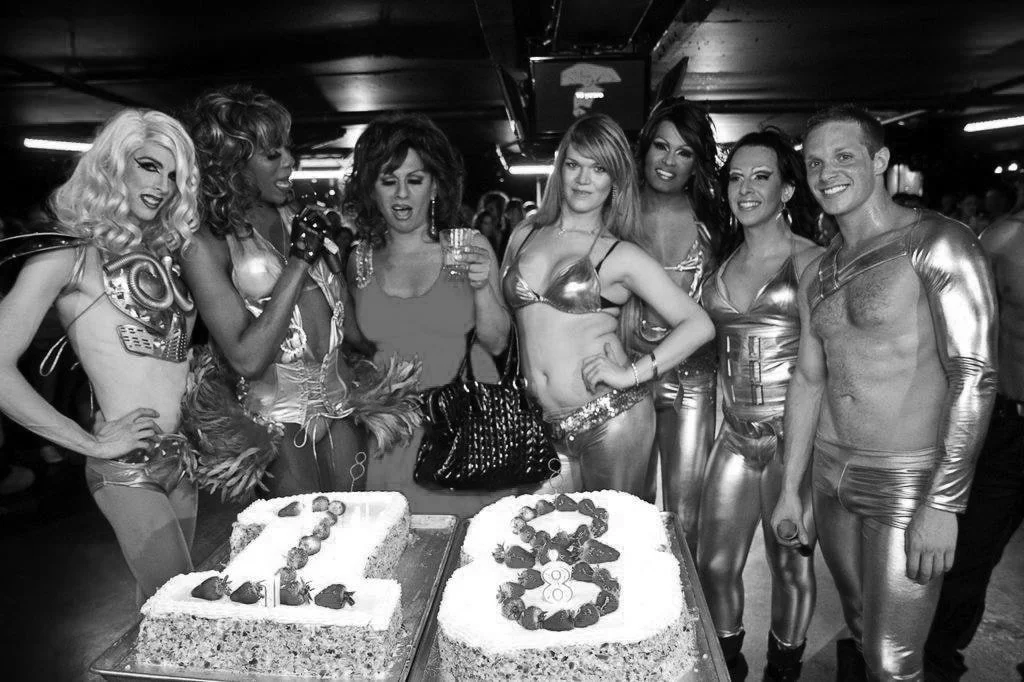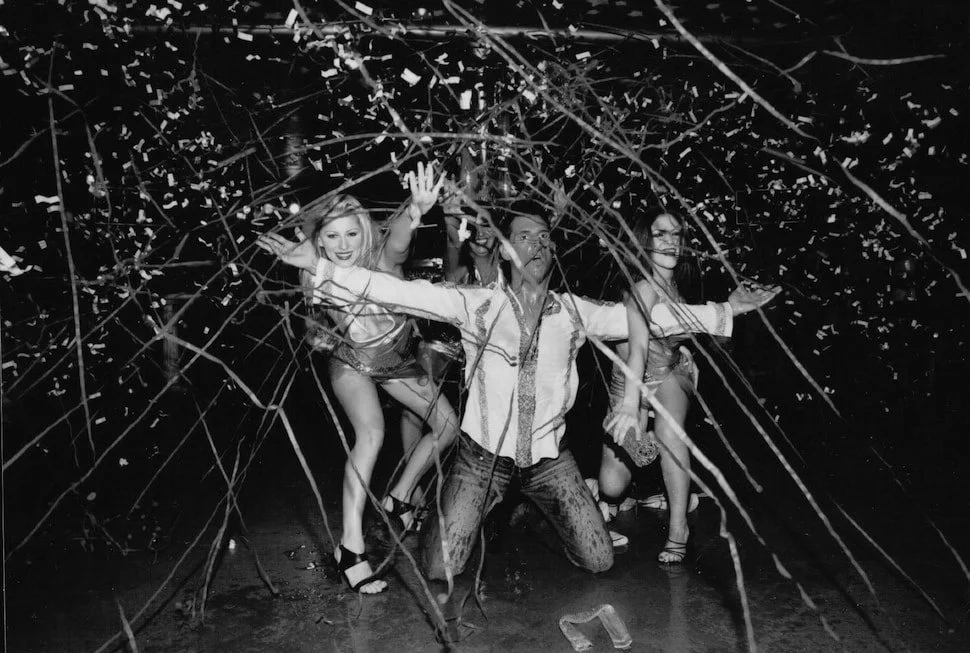LONG LIVE THE QUEENS
from the Archives
FROM DECEMBER 2017 ISSUE OF WEST END PHOENIX
The nocturnal life force of El Convento Rico belied the heterosexual pose of College Street. While scenesters and Italo-Canadians gathered in the strip’s cafés and restaurants, Toronto’s West End drag community performed in the underground bar to roaring crowds looking for a place to come together.
Thirty years ago, El Convento Rico threw its doors open to College Street and became the West End’s liveliest and most welcoming nightclub. To mark the anniversary, we spoke to patrons, performers, employees, a few detractors and its formidable matriarch, Maritza Yumbla, about the power of belonging, the importance of bedazzling and the meaning of drag
THE HOLY MOTHER
“When we first opened, there was gay bashing. We had tomatoes thrown at the doors. Most of our performers were performing secretly because people would give them trouble back then. Some even had families that didn’t know what they were doing.
Being a young Latina immigrant in the ’90s, I faced a lot of pushback myself: people saying I wouldn’t make it, and basically feeling like a second-class citizen. I opened El Convento Rico when I was 27 and I had to prove all those people wrong. [In those days] the gay community was facing a lot of discrimination, so at the beginning maybe we discriminated back a bit and said, ‘No straight people.’ That’s how it was for a while: You could only come in if you were gay. Then one day one of my performers asked if she could bring her family to watch one of the shows she was in. I said of course, and it progressed slowly from there.
El Convento means ‘the convent’ in Spanish. When I was a little girl, I always wanted to be a nun. It might sound funny but I loved their habits: I just thought they were so elegant. The nightlife industry is pretty much the opposite of a church, but I wanted to have a convent of my own. At El Convento Rico, I’m Mother Superior.” — MARITZA YUMBLA, OWNER
“In the beginning, Rico’s was a straight club, but it wasn’t working. Then one of the big guys that we all know in the Spanish community talked to Maritza about trying out Convento Rico on Sundays. We all went there and loved it – and it was busy. So she decided to try it the whole week. But you know, it didn’t work on Monday, Tuesday, Wednesday – no. People don’t go out to this kind of place on a weekday. So she only kept it open on the weekend. Fridays and Saturdays they had the shows, then on Sundays they had dance classes and a free buffet to bring people in.
I was crowned the very first Miss El Convento Rico, in 1992, and I still go there every Saturday. I got my start at another bar, La Pantera Rosa – The Pink Panther [at College and Euclid]. It was a little bit sketchy, and they were using us. The owners were straight dudes. But not straight like Maritza is straight. Maritza is a straight woman but she goes all the way in terms of helping us drag queens and making us feel at home. We are safe there because she didn’t let and doesn’t let anybody bother us. We are first to her.” — NICOLE BATISTA, MISS EL CONVENTO RICO 1992–’93
“Maritza taught me a lot about business. She believed that if you have a successful formula, don’t change it. So Rico has had a drag show every single Friday at 1 a.m. and Saturday at 12:30 a.m. for 25 years.
She believes in the importance of entertainment and would not tolerate shoddy performances. I witnessed her yelling at drag queens who she felt did not put enough effort into their costumes. I also remember in the early days when she would personally be involved in choreographing and producing the pageants from top to bottom. I remember once seeing her teach a whole group of young queens who had recently come to Canada how to properly walk in heels.
She also believes that everyone should be treated equally. One night, Titanic director James Cameron came to the club. His assistant or friend or whoever went to the front of the line to ask if he could skip the line. Maritza said, ‘I don’t care if the Queen of England is in the line, everyone has to wait.’ James Cameron waited, and I was told that he was actually impressed that he was treated that way.” — TODD KLINCK, FORMER MANAGER OF EL CONVENTO RICO
THE PULSING AMOEBA
“One Saturday night, in the mid’90s, when I was 26 or 27 and visiting Toronto from snoozy London, Ont., I jumped at the chance to check out a drag show at Club Rico. That night, the featured performer gave off an Almodovarian vibe: middle-aged, maybe a bit zaftig, big back-combed wig. She wore an elaborate gown. Her makeup sparkled in the club light wash. And whoa boy, did she have pipes. I don’t remember all the songs she performed, but I will never ever forget her rendition of “Total Eclipse of the Heart,” which she sang, naturally, in Portuguese.
The centrepiece of this particular performance was the surprise arrival of a suitor, a young man, Bay Street type, grey suit and tie, crisply parted hair, who stormed the stage, so beguiled was he by this passionate woman. He got on one knee; she picked him up. She rebuffed his advances, but he wouldn’t let up. Then, unable to deny their mutual ardour any longer, she pulled down his trousers and they dropped to the floor and proceeded to simulate sex on the stage.
The crowd lost its mind. We were praying for this conclusion – that this layered, complex, transgressive, forbidden love should find its fulfillment. The feeling was so palpable: Their fucking was our fucking. Their satisfaction was our satisfaction. There was no gay or straight. There was just human longing – which all of us understood.” — DAVID WHITTON, PATRON
“I lived not far away from El Convento Rico in the early ’90s, and for a while dropped by to merge into the sweaty den of bodies dancing, very dark with strobey lights and the glam drag show at midnight. It was a great place to dance solo, rubbing up against women and men, running my eyes and thoughts along the various contours. As a bi woman I felt relatively unharassed and able to crush in whatever direction took my fancy.” — MARGARET CHRISTAKOS, PATRON
“You don’t know who is who there. And that’s why a lot of people go, because everything goes. It’s dark, it’s crowded. Somebody touches your butt and you don’t know who touched you. A lot of people like that.” — NICOLE BATISTA, MISS EL CONVENTO RICO 1992–’93
“My first time at El Convento Rico, I was there with friends. The night was young, the dance floor not yet the wall-to-wall pulsing amoeba that it would become. I don’t remember who caught whose glance first, but I was suddenly face to face with someone who fit every assumption I had about the kind of person I’d find at ECR. Her soft voice, impeccable makeup and fabulous blonde wig were at odds with her aggressive, chiselled facial features. I was a bit thrown.
It didn’t help that in addition to being in the closet, I was a few years into my small-town immersion as a student at the University of Guelph. [That’s where I] found my hip-hop-loving, cowboy-boot-wearing tribe, and this weekend jaunt back into the city had me feeling disoriented.
But there we were – a closeted, Black lesbian in cowboy boots and a soft-spoken, blonde drag queen in the middle of a relatively empty dance floor. That’s when she offered to give me a reading. I thought, Why not? The evening had already started to feel like an out-of-body experience. I believe she asked to hold a ring I was wearing. She proceeded to relay some deep truths about my family and my relationship with my estranged father. How did she also know I was grappling with the potential fallout on the precipice of my coming out? I was going through a lot at the time, and she read me. I remember thinking, Whoa – how are you seeing me so clearly in the midst of all of this? She just sort of appeared and then went away. The night picked up. The energy of the crowd took over. I had a good time. But a part of me stood there motionless – still a little thrown – but not because I was feeling like a fish out of water. The frenzy of the dance floor mirrored my inner turmoil, but for a fleeting moment I had been seen.” — LAURIE TOWNSHEND, PATRON
“I first came to Toronto in October ’92 and I was a medical student then, working at Toronto Western. It was the era of Boots and Colby’s. I remember the person I was dating saying, ‘Well, you know, there’s this other club if you’re tired of Boots.’ And I was so tired of Boots. It was tired! I thought, Yeah, let’s go there. It’s not really queer, but there are enough of us and they don’t seem to mind.
It was always sort of intersectional. I remember a core Latin crowd, a small but very vocal Puerto Rican community. It definitely felt like a straight club. You saw all these hetero couples, but we never felt excluded or marginalized. And it was freer than even some of the queer spaces. I didn’t go to hook up: I went for the music and to dance and to see our friends perform on Saturday nights when the drag queens performed.
There wasn’t an official Black queer night, but when [drag legend] Michelle Ross performed, there’d be a dozen or two dozen of us there, dancing, cheering her on. We would just claim that space. We would just behave like it was a queer club. We didn’t wait to be given permission. But it was okay. We were never asked questions. [Back then] the straight patrons didn’t appear to feel awkward about us.” — ZUN LEE, PATRON
“Everybody is accepted – acceptable – there. Everybody does what they want. You wanna wear a wig, wear a wig. You wanna wear a costume, wear a costume. Nobody’s gonna be criticizing you for what you wear or the way you dance. Some places you go, if you don’t know how to dance, you feel uncomfortable and people push you away. But this place, no. I usually go as a girl. And when I go in drag, I know exactly who I am.” — NICOLE BATISTA, MISS EL CONVENTO RICO 1992–’93
“I performed there once with The Scandelles, way back in the day, 15 years ago. I was also on a panel of judges once with Moses Znaimer around the same time; I was a drag king judging a drag queen contest and I remember this night quite well. I was of course younger then and I was dressed in a dapper outfit and looking handsome. I got hit on a few times. When I told the men who were hitting on me that I was a drag king, they laughed and asked me to tell them about it. It’s mostly a space for queens – it doesn’t really call out to this king – but it was all very friendly.” — DRAG KING FLARE
CUE THE BRIDESMAIDS
“The bar itself was a lot more gay at the beginning. But then a lot of [straight] girls started coming. They liked to go to Rico’s to dance and have a good time. Sometimes girls just want to go to a place where guys aren’t bugging them. But then [straight] guys were finding out that a lot of [straight] girls were coming to this gay bar, and they started coming in, too. Little by little, gay people became less comfortable there, especially the ones not dressed up as women, because they didn’t know who was who. And sometimes [straight] guys would get offended. But we were protected by the bouncers. At the beginning they used to tell people at the door: ‘This is a gay bar. Are you okay with it? Are you cool? If you’re not cool, don’t bother coming in.’” — NICOLE BATISTA, MISS EL CONVENTO RICO 1992–’93
“For about 12 years, I lived down the street from El Convento Rico. I’m straight, but most of my friends who went there were queer and looking for a safe space to dance. The crowd was equal parts friendly folk, who were there for the same reason as my friends; exceedingly drunk bachelorettes looking to get a six-pack and a thong all up in their face; and mostly sober creeps looking to pick up girls from the latter group. It was a pretty regular thing to see a calculating, good-looking straight guy make a beeline to the drunkest bridesmaid on the dance floor. It was funny until it wasn’t. Security was usually pretty vigilant about that sort of thing, but more often than not, it would get pretty sloppy before it got settled. A lot of the straight people who went inside should have had a ‘Pre-Regret’ stamp slapped onto their hands. If there was a drag event, it was almost always the most ‘normal’ part of the night, and a relief from the shit show of the bachelorettes.” — ALEX WILLIS, PATRON
“Now on Saturdays they have strippers for the bachelorette girls. [Before that] the girls were asking for that [from us]! One of our bartenders – a gay, very good-looking guy – and even me – as a girl – they were asking... well, we didn’t know exactly what they were asking for! This girl asked me, ‘Can you do a lap dance for my friend? She’s getting married.’ I agreed and she gave me $60 and I did it, but it was weird; you know, she was touching my fake boobies and all over and I had to touch her and it was funny. Nowadays, it’s more pro. The professional strippers come in around 11 p.m., before the drag show.” — NICOLE BATISTA, MISS EL CONVENTO RICO 1992–’93
“[In the early days] we never felt like we were in a zoo. Eventually, that’s what it felt like – like we became part of the attraction. Like, straight people want to be in this ‘exotic’ space where they are surrounded by this ‘transgressive’ element.
In the early years, it felt like just another queer club – even though it wasn’t queer. But it was queer, you know? Sometimes we’d go on Sundays when it was relatively empty – just Black queer men, hanging out. In 1995, ’96, ’97, it was still okay. But then we stopped going. A lot of the performers we’d go there to see moved more towards Church Street. Around that time, the clientele definitely changed. It was a different crowd, and it felt like they were wondering why we were there, why we were dancing with each other. And the looks started. The segregation started. Before when we danced, we were interspersed with the straight people. And then at some point it seemed like we had our own little section of the dance floor – we were cordoned off. It had been a rather free, freeing space, and then it became something else. And we stopped going. We didn’t want to negotiate the question of whether we were welcome or not anymore.” — ZUN LEE, PATRON
“Like anywhere, you’ll run into people who are unaware and uneducated about drag culture. One night after our show, we went out for some food and literally steps away from Rico’s is where we ran into some trouble with a group of men. There was name-calling, some threats, but we walked away before anything got physical.” — MONA MOORE, MISS EL CONVENTO RICO 2017–’18
“If you’re not a cis-het bachelorette, or a queer guy, or a drag queen out-femme-ing and out-queering both, El Convento Rico is a tough space.
We were a group of seven women, mostly queer, mostly butch – brought there by the best woman of a wedding party, who wanted to find a queer dance space for the queer brides-to-be. In a city this size, with a LGBTQ+ population this size, this can be a surprising challenge – especially for women.
Everything about this space should have made for an amazing night – great music, queer space, dancing, drag queens – but it wasn’t an amazing night. I stayed only because we were there for friends, and I haven’t been back. We couldn’t get a server’s or bartender’s attention. We couldn’t hold space on the dance floor. We couldn’t have a conversation without a dude walking through, as if we weren’t actually there. And all around us, incredibly drunk young women were being pulled onto the dance floor to endure the antics of agro stripper simulations.” — BRANDY RYAN, PATRON
“Drag didn’t used to be a straight spectacle, but I think it has become that, with reality TV and such. And I think straight women have kind of co-opted the queer agenda and the language – ‘honey this’ and ‘honey that’ and ‘throwing shade.’ It’s a kind of appropriation. I think the owners [of ECR] realized that straight women love this stuff – the drag shows, the queer people. I don’t think it’s a phobic environment, but now queer people are part of the spectacle. We’re part of the show. And I’m, like, no. It’s weird to be gawked at, and I remember it distinctly. The only time I went later on was during Caribana, when there were massive amounts of Black people there. We’d take over the space and reclaim it. For that one time of the year it felt like our space again – and then that changed, too.” — ZUN LEE, PATRON
DAYS OF FUTURE PAST
“I was in my early 20s and I needed a job. My mom knew Maritza’s sister, so I planned to do my one coat-check shift at ECR to appease my mom and then never return. I’m not Latin, I’m not gay, I didn’t even like clubs. But it’s impossible not to love the people, and 10 years later, I’m still here. I became night manager in 2012. We have a lot of long-term employees, which is rare in the service industry. Like me, people just don’t want to leave the family.
We’re on Facebook and Instagram now, but social media is relatively new for us. Maritza has always believed in old-school, word-of-mouth publicity. Only once in 25 years has she advertised. When I started working at ECR, you found out which queens were performing on a given night by reading their names on the marquee as you approached the club.” — JULIA STANLEY-CAREY, NIGHT MANAGER
“In the beginning, when we went to see the show at Club Rico, the Internet was just bulletin boards and AOL floppy disks. Now it’s a repository for the collective ego and id. In the mid-’90s, a Rico show could be huge, hilarious, transformative. And it was available only to those who were there.” — DAVID WHITTON, PATRON







